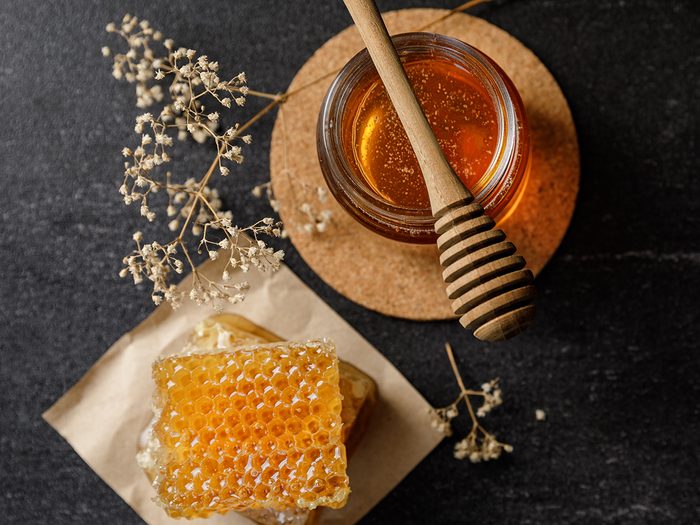The Health Benefits of Honey (Beyond Soothing Sore Throats)

Only in recent years have scientists discovered the science behind the health benefits of honey, long put to good use in treating wounds, soothing sore throats and nourishing skin. In turn, this has led to a range of new treatments
Honey is not only popular for baking, toast and tea, it’s also a great home remedy and has several different uses. It is used as an antibacterial agent, effective wound dressing, remedy for sore throats and tickly coughs and as a face mask to relieve dry skin. The best part is, it’s readily available—you probably already have some at home.
(Related: Try our recipe for Rustic Honey-Roasted Carrots with Thyme)
How to use honey as a health remedy
Honey has a wide variety of health benefits and can likewise be used for a wide variety of ailments. Aiding in the healing of wounds, sore throats and dry skin are only a few of the ways honey can boost your health.
For grazes, minor burns and cuts: Slather some honey then cover the wound with clean gauze. Change the dressing 2 or 3 times a day.
For sore throats and tickly coughs: Honey is known as a demulcent, which means it coats the throat as it is swallowed and so eases irritation. The sweetness of the honey also encourages salivation, so easing a dry throat and encouraging expulsion of phlegm. Steep 2 tablespoons (10 mL) of grated ginger root in 1 cup (225 mL) of boiling water for 10 minutes. Add 2 teaspoons (10 mL) of honey and 1 teaspoon (5 mL) of lemon juice. Drink before bed.
For dry skin and acne: Bathe the face in warm water to open the pores, then apply a layer of honey to the skin and wash off after 20 minutes. You can then apply a face mask made with mashed avocado and olive oil; the oil will provide moisturizing oils (alternatively, whisk in some milk’its lactic acid helps soften dry skin). Adding oatmeal will create a scrub that will help remove dead skin cells.
Alternatively, you can purchase ready-made honey products, which are available from several pharmaceutical and natural health companies; these include wound dressings and gels. Ask your pharmacist for further information on these products and their particular benefits.
(Related: 3 Simple Sore Throat Remedies that Are in Your Pantry)
Who is honey recommended for?
Children under 12 months should not ingest raw honey because there is a small chance that it contains bacteria that could be harmful to an underdeveloped immune system.
What honey should you choose?
Since honey is made by bees from the nectar of plants, its composition varies depending on where it comes from and which plants the bees have been foraging on. Manuka honey is made by bees foraging on the manuka tree, which is native to New Zealand and parts of Australia. Large randomized controlled studies have shown that manuka honey is superior to other types of honey in terms of its antimicrobial properties. As well as being antimicrobial, Manuka honey aids the removal of dead tissue from wounds and moistens the affected area, making it more comfortable and easier to remove and reapply dressings.
The best choice when using honey as a health remedy is honey that is “raw,” meaning that it has not been pasteurized, as pasteurization denatures some of its enzymes and makes it less effective.
Try Wedderspoon Raw Manuka Honey KFactor 16 ($23).
What is “Medihoney”?
You may have seen products in the pharmacy labelled “Medihoney.” Medihoney is derived from Manuka honey and formulated, marketed and sold as a line of medical-grade honey products. Medihoney is used in special impregnated bandages, dressings and gels to aid the healing of wounds, especially pressure sores and leg ulcers.
(Related: Try our recipe for a Honey Poppy Seed Fruit Salad)
Modern research and studies on honey
Though researchers have known about the antibacterial qualities of honey for some time, it is only recently that they have been able to suggest what might be the source of these qualities. Dutch researchers at the Center for Infection and Immunity Amsterdam put it down to a protein that bees add to honey called defensin-1. In 2010, they examined the effects of medical-grade honey on a range of bacteria in the laboratory and then divided the honey up into different chemical components. The most potent antimicrobial action was shown by defensin-1. The discovery could lead to new antibiotics and honey-based medical treatments.
However, research at Cardiff Metropolitan University suggests that honey works by inhibiting the formation of biofilms, slimy sheets formed by microorganisms hooking up together, which conventional antibiotics have trouble penetrating. Both may be correct: it is likely that honey’s effectiveness is due to a number of mechanisms that work together.
Did you know?
Honey may not be the only medicinally useful substance derived from bees. Researchers at the Washington University School of Medicine in St Louis, Missouri, have been looking at melittin, a component of bee venom. This peptide is known to have an ability to target renal, lung, liver, prostate, bladder and mammary cancer cells, as well as leukaemia cells. The researchers have been modifying melittin so that they can attach compounds to it and use it as a ‘transporter agent.’ The melittin could then, for example, carry therapeutic compounds or indicator dyes straight into the heart of tumours.




